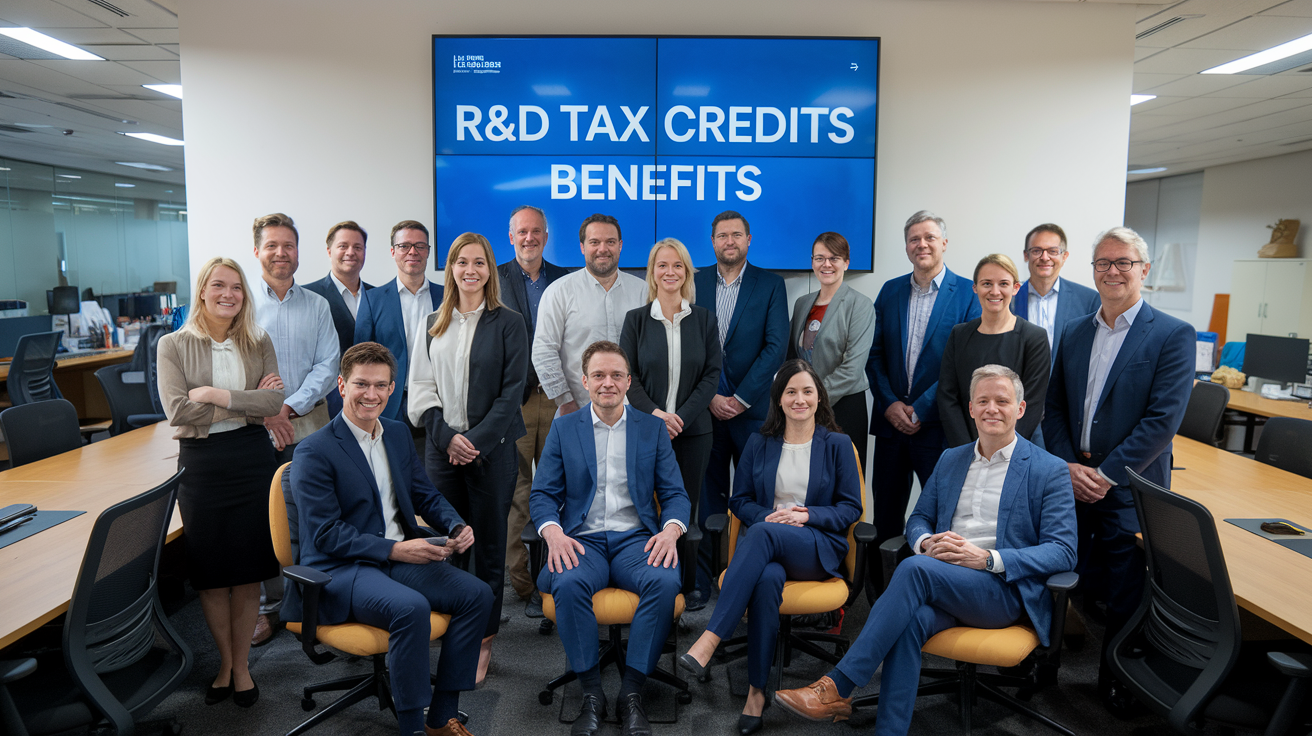R&D Tax Credits Cheltenham Gloucestershire
R&D tax credits in Cheltenham, Gloucestershire, are a valuable government incentive designed to support innovative businesses by providing corporation tax deductions or cash payments for research and development activities. These credits reward businesses for investing in innovation, serving as a significant source of funding for growth. HMRC defines R&D as activities that seek to resolve scientific or technological uncertainties, which can include software development, product development, scientific research, and technological inventions.
To qualify, your business must be involved in projects that aim to resolve scientific or technological uncertainties. This includes a wide range of activities such as developing new software, improving existing products, and enhancing internal processes. Eligible costs include salaries, National Insurance Contributions (NIC), pensions, subcontractor costs, consumables, and certain software and capital expenditures. From April 2023, costs such as data and cloud computing expenditures are also eligible, provided they are not recouped. R&D Tax Credits UK can help you navigate these complexities and ensure you maximize your claims accurately and compliantly.

How Do R&D Tax Credits Benefit Cheltenham Businesses?
R&D tax credits can significantly benefit Cheltenham businesses by reducing their tax liability and providing financial incentives for innovation. These credits encourage businesses to invest in research and development, driving economic growth and competitiveness.
Financial Advantages
R&D tax credits offer substantial financial benefits to Cheltenham businesses. By claiming these credits, businesses can reduce their tax burden, which can result in significant savings. For instance, small- and medium-sized businesses in the UK can save around £20,000 per year on average using R&D tax relief.
This financial relief can be crucial for businesses, especially during the early stages or when facing financial constraints. The savings can be reinvested into further research and development, hiring more staff, or improving infrastructure, thereby boosting the overall growth of the business.
Competitive Edge in Innovation
R&D tax credits give Cheltenham businesses a competitive edge in innovation. By incentivizing investment in research and development, these credits enable businesses to develop new products, processes, and technologies. This can include activities such as creating new software applications, improving manufacturing processes, or designing innovative engineering solutions.
The ability to innovate and stay ahead in the market is vital for businesses in competitive sectors. R&D tax credits support this by providing a reliable financial base for long-term R&D planning, allowing businesses to focus on innovation without the immediate financial strain. This support can lead to higher profitability and increased attractiveness to potential investors, ultimately enhancing the business's valuation.

Which Industries Commonly Claim R&D Tax Credits?
Businesses across various industries in the UK can claim R&D tax credits, but some sectors are more prevalent in utilizing this incentive. The manufacturing, technology, and life sciences sectors are among the top claimants.
Technology Sector
The technology and software development sector is a significant beneficiary of R&D tax credits. Companies in this sector often engage in activities such as developing new software, improving existing applications, and creating innovative technology solutions. For example, IT and software companies can claim for projects involving the development of analytics software, automated systems for materials handling, and innovative methods of capturing and protecting data.
Manufacturing
The manufacturing industry is the largest sector claiming R&D tax credits, with a substantial number of claims submitted annually. Manufacturing companies frequently undertake R&D activities to develop new products, improve existing processes, and comply with changing regulatory standards. This includes projects such as product development using computer-aided tools, developing second-generation products, and creating processes to meet increasing regulatory requirements.
Life Sciences
The life sciences sector, including healthcare and pharmaceuticals, heavily relies on R&D to drive innovation. Companies in this sector can claim for activities such as developing new drugs, medical devices, and health technology solutions. Projects like testing and creating new product prototypes, reducing side effects of pharmaceuticals, and developing software solutions for electronic medical records are all eligible for R&D tax credits.
Others
Other industries also benefit significantly from R&D tax credits. For instance, the construction industry has seen a notable increase in R&D spending, with companies claiming for innovations such as new materials, automated systems, and eco-friendly solutions. Additionally, sectors like oil and gas, farming and agriculture, and professional, scientific, and technical services also have a high potential for claiming R&D tax credits due to their innovative activities.

What Qualifies as R&D Under UK Tax Law?
To qualify for R&D tax credits under UK tax law, your project must seek to make an advance in science or technology and overcome scientific or technological uncertainty. This advance must benefit the field overall, not just your business.
Qualifying Activities
Qualifying activities for R&D tax credits involve projects that aim to resolve scientific or technological uncertainties. Here are some key points:
- Advance in Science or Technology: Your project must look for an advance in science or technology that benefits the field overall, not just your business.
- Overcoming Uncertainty: The project must involve overcoming uncertainties that an expert in the field cannot easily resolve.
- Development of New Products or Processes: This can include developing new products, services, or processes, or improving existing ones.
- Qualifying Costs: Eligible costs include staff costs, subcontractor costs, materials and consumables, software licences, and certain data and cloud costs.
Excluded Activities
Certain activities do not qualify for R&D tax credits:
- Arts, Humanities, or Social Sciences: Projects in the arts, humanities, or social sciences, including economics, are not eligible.
- Routine or Standard Practices: Activities that involve applying existing techniques or technology without any technological advance are excluded.
- Non-Technological Innovations: Projects that do not involve scientific or technological innovation, such as developing a new website using standard techniques, do not qualify.
- Certain Industries: Activities from care homes, childcare providers, personal trainers, wholesalers, retailers, pubs, and restaurants are rarely eligible.

How Are R&D Tax Credits Calculated?
R&D tax credits are calculated based on the qualifying research and development expenditure of your company, with the calculation method varying depending on whether you use the SME Scheme or the RDEC Scheme. The amount you can claim is directly tied to the enhanced rate of your qualifying expenditure and the applicable corporation tax rate.
SME Scheme
For companies eligible under the SME Scheme, the calculation involves enhancing your qualifying R&D expenditure. Prior to April 2023, this enhancement is 130% of the qualifying expenditure. For example, if you spent £100,000 on R&D activities, the enhanced expenditure would be £130,000. For profitable companies, this amount is then subject to the corporation tax rate of 19%, resulting in a claim value of £24,700.
For loss-making companies under the SME Scheme, the enhanced expenditure is £230,000 (£100,000 + £130,000), and you can surrender this for a cash credit at a rate of 14.5%, yielding £33,350.
From April 2023, the enhancement rate for SMEs will decrease to 86%, and the credit rate will reduce to 10%. For profitable companies, this means a claim value of £21.50 for every £100 spent on R&D activities, while loss-making companies can claim £18.60 for every £100 spent.
RDEC Scheme
The RDEC Scheme is applicable for larger companies or those that do not meet the SME criteria. Under this scheme, the tax credit is calculated as a percentage of the qualifying R&D expenditure. Prior to April 2023, this rate is 13%, providing a tax credit of £13 for every £100 spent on R&D activities. However, this credit is taxable, resulting in a net benefit of £10.53 after corporation tax.
From April 2023, the RDEC rate will increase to 20%, providing a tax credit of £20 for every £100 spent on R&D activities, with a net benefit of £15 after tax.

What Are the Recent Changes to UK R&D Tax Credits?
The recent changes to UK R&D tax credits involve significant reforms aimed at simplifying the system, curbing fraud, and providing enhanced relief for R&D-intensive businesses. These changes, introduced in the Autumn Statements of 2022 and 2023, have reshaped the R&D tax relief landscape.
Policy Updates
- Merging of Schemes: The SME R&D Tax Relief and the Research and Development Expenditure Credit (RDEC) schemes have been merged into a single RDEC-like scheme for all businesses, effective from 1 April 2024.
- RDEC Rate Increase: The RDEC rate has increased from 13% to 20% for accounting periods starting on or after 1 April 2023.
- SME Relief Adjustments: For SMEs, the additional deduction decreased from 130% to 86%, and the SME credit rate reduced from 14.5% to 10% for loss-making entities, effective from 1 April 2023.
- R&D Intensive SME Relief: A new scheme for R&D-intensive SMEs, where qualifying R&D expenditure is 30% or more of total expenditure, offers enhanced relief of up to 27%.
- PAYE and NIC Cap: A relief cap based on PAYE and NIC has been introduced to ensure the system benefits UK companies and contractors.
- Expanded Cost Categories: A wider range of cost categories, including pure mathematics and data/cloud computing costs, are now eligible for tax relief.
Impact on Businesses
- Simplified Process: The merger of the schemes aims to simplify the application process, although complexities still exist, particularly in defining R&D intensity and handling temporary fluctuations in R&D expenditure.
- Reduced Benefits for Some SMEs: The changes have resulted in reduced benefits for some SMEs, with the effective rate for loss-making SMEs dropping from 33.35% to 18.6% before the latest adjustments.
- Enhanced Relief for R&D-Intensive SMEs: Despite overall reductions, R&D-intensive SMEs can now claim higher rates of relief, up to 27%, which is a positive change for businesses heavily invested in R&D.
- Increased Compliance Scrutiny: HMRC has tightened compliance checks to prevent misuse, making it crucial for businesses to seek professional advice to ensure legitimate claims.
- Grace Period for R&D Intensity: Businesses that fail to meet the R&D intensity threshold due to unexpected circumstances are given a one-year grace period to maintain their status, simplifying temporary fluctuations.

How Can Cheltenham Businesses Apply for R&D Tax Credits?
To apply for R&D tax credits, Cheltenham businesses need to ensure their activities meet the qualifying criteria set by HMRC and follow the specific application process. This involves identifying and documenting R&D projects that aim to achieve an advance in science or technology.
Application Process
- Identify Qualifying Activities: Determine if your business is engaged in projects that improve existing products, create new products, or enhance manufacturing or software processes. This includes activities like developing new algorithms, improving software performance, or enhancing product quality.
- Notify HMRC: For new claimants or those who have not claimed R&D tax relief in the last three calendar years, notify HMRC within six months of the end of the accounting period in which the R&D took place. This is done using a standardised claim notification form.
- Prepare and Submit the Claim: Ensure all necessary documentation is gathered and the claim is prepared accurately. Claims must now be submitted digitally via HMRC's online tax return portal.
- Include Required Details: The claim must include details of the projects undertaken, a breakdown of the qualifying costs, the workers involved in R&D activities, and details of the agent that helped prepare the claim.
Required Documentation
- Project Details: Provide a detailed description of the R&D projects, including the objectives, the technological uncertainties addressed, and the methods used to overcome these uncertainties.
- Cost Breakdown: Document all qualifying costs, such as wages, materials, and subcontractor fees. From April 2023, this also includes data and cloud computing costs, provided they are not recouped.
- Worker Information: List the workers involved in the R&D activities, including their roles and the time spent on these activities.
- Agent Details: If an agent or consultant helped prepare the claim, include their details in the submission.
By carefully following these steps and ensuring all required documentation is in place, Cheltenham businesses can successfully apply for R&D tax credits and benefit from the financial incentives provided.

What Common Mistakes Should Be Avoided When Claiming?
When claiming VAT or taxes, it is crucial to avoid mistakes that can lead to penalties, fines, and additional costs. Here are some key areas to focus on to ensure accuracy and compliance.
Overclaiming
Overclaiming VAT or taxes can result in severe consequences, including penalties and interest. For instance, HMRC strictly monitors claims for VAT on fuel and cars, and claiming VAT on fuel used for personal travel without proper records can lead to errors. Ensure you have accurate mileage records or use the scale charge to account for personal use.
Underclaiming
Underclaiming VAT or taxes can also be problematic, as it may result in missed opportunities for legitimate deductions. Failing to claim all available deductions, such as expenses for office supplies, travel, and equipment, can reduce your tax liability. Make sure to keep accurate records and claim all eligible expenses to avoid underreporting.
Documentation Errors
Documentation errors are a common pitfall when claiming VAT or taxes. You must produce evidence in the form of a VAT invoice to reclaim VAT on any business expense. Without proper documentation, such as a VAT invoice or alternative evidence like a bank statement, you cannot claim VAT. Ensure all paperwork is in order and follow up on any outstanding or late invoices before filing your tax return.
Additionally, incorrect valuation of goods during import can lead to Customs imposing or estimating a real value, resulting in higher duty and VAT payments. Always use the correct commodity codes and ensure you have proof of origin to avoid complications and penalties.

How Can Professional Advice Enhance R&D Tax Credits Claims?
Professional advice can significantly improve the accuracy and success of your R&D tax credits claims by ensuring you meet all the necessary criteria and submit a comprehensive claim. This expertise helps you navigate the complex R&D tax relief system, maximizing your potential savings.
Role of Tax Credit Specialists
When you engage with R&D Tax Credits UK, our tax credit specialists play a crucial role in several key areas:
- Assessment and Eligibility: They determine whether your business activities qualify for R&D tax credits, ensuring you meet the criteria set by HMRC, such as developing new products, services, or processes, and investing money in these developments.
- Documentation and Evidence: Specialists help you document the uncertainties and planned innovations at the start of your projects, providing the necessary evidence to support your R&D claims. This includes keeping a timeline of activities and their purposes to detail when the business starts to move into the production phase.
- Claim Preparation: They take responsibility for preparing and filing your R&D claims, ensuring all necessary information is included, such as details of projects undertaken, a breakdown of qualifying costs, and the workers involved in R&D activities.
- Compliance with Regulations: Experts ensure your claims comply with the latest regulations, including the new requirement for digital submission of corporation tax returns that include R&D claims and the need for advance notification to HMRC for new claimants.
Benefits of Expert Guidance
The benefits of seeking expert guidance from R&D Tax Credits UK are numerous:
- Maximized Claims: Specialists help you identify all qualifying R&D expenditure, ensuring you claim the maximum amount you are eligible for. This includes costs such as data and cloud computing, which are now eligible under the extended qualifying costs.
- Reduced Administrative Burden: By handling the complexities of the R&D tax relief system, our experts reduce the administrative burden on your business, allowing you to focus on your core activities.
- Compliance and Risk Mitigation: Expert guidance ensures that your claims are accurate and compliant with HMRC regulations, mitigating the risk of errors or fraudulent claims that could lead to HMRC enquiries.
- Improved Cash Flow: Successful R&D tax credit claims can significantly improve your business's cash flow by reducing your corporation tax liability or providing a cash repayment from HMRC.
By leveraging the expertise of R&D Tax Credits UK, you can ensure that your R&D tax credits claims are handled efficiently and effectively, leading to substantial financial benefits for your business.
In Conclusion
R&D tax credits in Cheltenham, Gloucestershire, are a vital incentive for businesses to invest in innovation, driving economic growth and competitiveness. These credits, managed by HMRC, offer corporation tax deductions or cash payments for qualifying research and development activities, such as software development, product innovation, and technological advancements.
The recent changes to the R&D tax credit system, including the merger of the SME and RDEC schemes from April 2024 and the increased scrutiny by HMRC to prevent fraud, highlight the need for precise and thorough claim preparation. Businesses must now provide detailed project descriptions, breakdowns of qualifying costs, and endorsements from senior officers, all submitted digitally.
To navigate these complexities and maximize your claims, seeking professional advice from R&D Tax Credits UK is crucial. Our specialists ensure your claims are accurate, compliant, and comprehensive, helping you identify all eligible costs and mitigate the risk of errors or HMRC enquiries. By leveraging our expertise, you can optimize your R&D tax credits, improve your cash flow, and reinvest the savings into further innovation and growth.
If you are a business in Cheltenham, Gloucestershire, involved in research and development, do not miss out on these valuable incentives. Contact R&D Tax Credits UK today to ensure you are taking full advantage of the R&D tax credits available to you. Our team is here to guide you through the process, ensuring you receive the maximum benefits for your innovative efforts.

